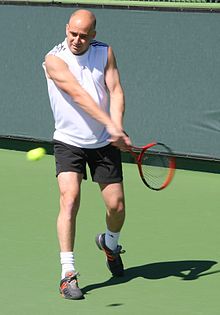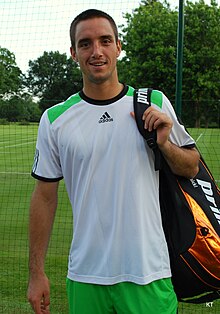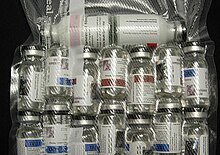Doping in tennis
[3] Anti-doping policy within tennis primarily developed from the 1980s with the increased prevalence of recreational drugs and steroid use among athletes across various sporting professions.
[5] The International Tennis Federation (ITF) and the World Anti-Doping Agency were initially seeking a two-year ban because of the substance used in the incident.
[7] In January 2010, the Court of Arbitration for Sport found Gasquet not guilty of a doping offence and he returned to professional tennis following the ban at the Australian Open in 2010.
[10] The International Tennis Federation (ITF) recognised Cilic's claim and did not hand down the regular two-year professional ban for instances of illegal doping.
[10] However, following a successful appeal to the Court of Arbitration for Sport, Čilić's nine-month ban was reduced to four months, with a retrospective provisioning period recognising time already spent away from the game.
As part of the 2013 anti-doping program administered by the governing body, it is compulsory that when requested by ITF staff, that players provide in and/or out-of-competition blood and urine testing.
[16] The punishment also enforced the forfeiture of all ATP World Tour points and prize money received at the 2013 Monte Carlo Masters tennis tournament where he refused to participate in the blood test.
[18] In 2024, Jannik Sinner returned two positive drug tests for the use of anabolic steroid clostebol, a prohibited substance which is very popular in Italian sport.
[23] Examples in WTA Tour include: In 2007, Martina Hingis tested positive to the drug benzoylecgonine, a substance that has traces to cocaine.
Záhlavová-Strýcová stated she did not deliberately ingest the drug to lose weight or cheat in competition, but did admit to using a weight-loss supplement Acai Berry Thin which has the substance as one of the ingredients.
[29] The substance used was a drug named meldonium that is used to treat heart disease with its effects on blood circulation through the transfer of fatty acids into the human body.
[30] Sharapova maintained there was no wrongdoing on her behalf, having admitted to using the prescription based drug for over ten years due to her susceptibility to influenza, treatment for symptoms of diabetes and magnesium deficiency.
[29] As a result, Sharapova was initially issued a two-year ban by the ITF that prevented her from competing professionally on the WTA World Tour until 25 January 2018.
[29] Following an investigation by the Court of Arbitration for Sport in October 2016, Sharapova's ban was reduced from two years to 15 months after it was found there was no intention to cheat and no significant fault on her behalf.
[36] Simona Halep is a Romanian tennis player who has won two Grand Slam titles and reached the world number one ranking in 2017.
In October 2022, she was notified by then nascent International Tennis Integrity Agency (ITIA) that she tested positive for Roxadustat, an anti-anaemia drug that stimulates the production of red blood cells, at the US Open in September.
[37] The subsequent year in May she was charged with a second doping offence by the ITIA over “irregularities” in her biological passport (ABP), which monitors blood indicators over time.
[51] Anti-doping policy remains controversial due to the large amount of substances, ingredients and chemicals that athletes are prohibited from being exposed to.
[54] Another controversy surrounding doping policy is the strict times at which testing can be carried out that players must hold themselves to or face potential repercussions, as seen with Viktor Troicki in 2013.
[55] Further controversy revolved around Jannik Sinner who was allowed to continue to compete despite his two separate failed tests for the anabolic steroid clostebol.










